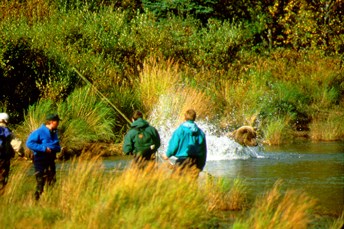
NPS/M. Fitz
Catch and Release EthicsMany places in Katmai experience heavy fishing pressure each year and many fish are caught multiple times in a season. Therefore, release fish as quickly and gently as possible to ensure their continued survival. In general, avoid playing a fish to exhaustion. As a fish is landed, keep it in the water when removing the hook. Fish can quickly suffocate when removed from the water. Use barbless hooks as much as possible. They are easier to remove and less injurious to fish. Fish Consumption Advisories in National Park WatersThe Environmental Protection Agency, states, territories, and tribes provide advice on fish and shellfish caught in the waters in their jurisdiction to help people make informed decisions about eating fish. Advisories are recommendations to limit your consumption of, or avoid eating entirely, certain species of fish or shellfish from specific bodies of water due to chemical or biological contamination. Fishing Throughout the National Park ServiceWe invite you to visit the Fish and Fishing website for more information about fish and fishing in the National Park Service. You will learn about conservation, different fish species, and parks that offer fishing. 
NPS Fishing Around BearsThe park’s annual salmon runs support some of the highest densities of brown bears on earth. No matter when you visit, fishing in Katmai requires extra care and responsibility to protect people, wildlife, and the experience. A splashing fish sounds like food to a bear. Bears will often move in your direction to investigate a fish on a line. Always be prepared to cut or break your line, so that you can free the fish and move out of the water until the bear passes. Never let a bear acquire a fish from you. It is easy to become so engaged in fishing, that you forget to be alert for bears. They are surprisingly quiet and difficult to see in dense grass or tall brush, so always have someone spot bears for you. At minimum, keep 50 yards between yourself and all bears. All fishing must cease when a bear is within 50 yards of you. No lures or flies can remain in the water. Stop fishing and move away well before a bear approaches within 50 yards. If bear is close and you hook a fish, you must lose your tackle to break your line or find yourself in a situation with a bear pursuing your fish. Guided Fishing OpportunitiesVisitors traveling on their own with the proper equipment and licenses are welcome to fish in Katmai. Many commercial operators offer guided sport fishing in the park and a list of those operators are found in the commercial services directory. The following six companies are exclusively authorized by concessions contract to provide jet-boat accessed fishing on American Creek: |
Last updated: April 14, 2022

